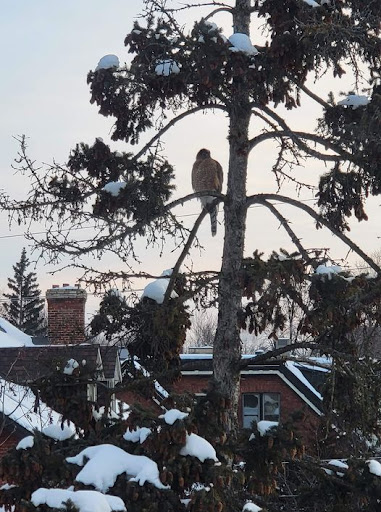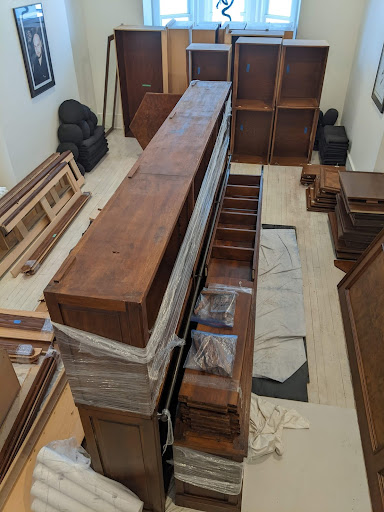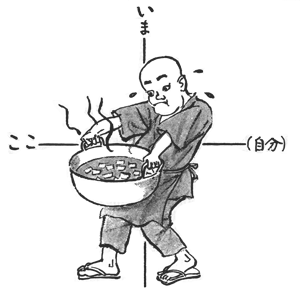
A visitor to Dainen-ji,
Photograph by Ven. Jinmyo Renge sensei
eMirror Vol 26, No. 10

A visitor to Dainen-ji,
Photograph by Ven. Jinmyo Renge sensei
eMirror Vol 26, No. 10
Friday, March 4th
Edited by the Practice Council
The White Wind Zen Community:
An international community practising and teaching Dogen’s Zen since 1985.
In order for music to be art it must be something other than merely background, not only to driving our car or eating in a restaurant, but also more than a background to our story about ourselves. More than the score to the blockbuster sensation, the Movie of Me. It must stand outside of the uses that we want to put it to such as alleviating boredom, recalling nostalgia, or giving us some extra support for working ourselves into a frenzy of loneliness or hysteria or resentment or achey-breakey heartedness. In order for music to be an art it must be met on its own terms.
When I encounter a composition that I find interesting, I often listen to it seven or ten times in a row. And when I encounter a composition that I truly dislike, I also listen to it seven or ten times in a row to find out why. And to find out if that is still the case after listening to the work through, discerning its structure, following the counterpoint, listening to how the instrumentation or conducting or performance is able to convey the structure successfully and so on. For example, for many years I had no use whatsoever for Brahms and his Four Symphonies. I found that a few works here and there were vibrant and had depth but often much of his work seemed merely stolid, seemed pedantically late German Romantic. I listened to three or four different recorded versions of the Four Symphonies many times and found a few passages interesting but, for the most part, the sound was too fatty, too larded. There was not enough space within the interactions for it to be interesting. Then, earlier this year, I found a recording done on instruments more or less of the period with a chamber orchestra, a smallish orchestra of the same size as the symphonies had originally been composed for. And suddenly I understood Brahms’ soundworld. These symphonies are still by no means amongst my favourite works to listen to but now they are interesting as art. So in order for music to be art it must be able to bear up under attentive listening and it should also inform the listening, change the listening. Art is something that changes you in some way rather than something which is merely used as part of your equipment to maintain yourself.
In order for music to be a Zen art it must emerge from an interest in hearing, in listening, in the coming and going of the sounds themselves. And for the listener it must light up something about the space of hearing, bring about an interest in hearing as such.
-Ven Anzan Hoshin roshi, continuing Class Three: The Sea of Sounds" in the series "Zen Arts: The Flowering of the Senses", October 1999 Daruma-ki O-sesshin, Dainen-ji.
Fusatsu: March 16th
March Two-day Sesshin:
The March two-day sesshin will begin at 8:00 p.m. on March 11th and will end at 6:00 p.m. on Sunday the 13th.
Keizan Ki
March 21st is the memorial for Keizan Jokin zenji.
Hermitage
The Roshi is currently in an extended period of "self-isolation" due to underlying health issues until the COVID-19 situation clarifies.
Beginning Instruction in Zen Practice
For information concerning our Long-distance Training Program, please visit this Web Page: https://wwzc.org/long-distance-training-program
Rev. Chiso anagarika sat her weekly semi-retreat on Tuesday, March 1st at her home in the Berkshires. Tarik Kaya sat a half-day retreat on Saturday, February 26th at his home in Ottawa, Ontario. Jean-Francois St-Louis sat a half-day retreat on Wednesday, March 2nd at his home in Luskville, Quebec.
If you would like to sit a retreat at home please follow the schedule outlined in this page: https://wwzc.org/retreat-schedule-public-students. After your retreat, please send an email to schedule@wwzc.org to confirm that you sat a retreat and include the duration and location.
Work has recently begun on converting the empty east wing rooms at Dainen-ji. The first part of the project is to build the Shuryo (a monastery Library and Study Hall) in the main section of the space. As you will have read about previously in the eMirror, Saigyo ino travelled to Toronto recently to dismantle and bring back a large second-hand oak and burled walnut library, which will be built into the new space.
As the dismantled library is currently being housed in the Zendo (one of our two practice rooms), it is a priority to get this room completed so that the Zendo is functional again for when the monastery opens to students and to the public.

Dismantled library currently in the Zendo
Saigyo ino has made arrangements to take two months of unpaid leave from his work to do the majority of the construction and, with as much help as possible from students, hopes to complete the work by May.
Although a great deal of money will be saved by having the Ino and students work on this project, funds are still required for the purchase of materials and to pay an electrician for the electrical work needed. If you are able to donate towards this project your help will be very much appreciated. All donations will be tax deductible. And if you would like to assist with the work, please contact the Ino at saigyo dot cross at wwzc dot org to discuss your schedule.
Thank you very much.
Here are a couple of renderings by the Ino which gives an idea of what the Shuryo will look like when completed.


Saturday, March 5th to Saturday, March 12th
Saturday, March 5th: "Drawn In, Moving Forth": Zen Master Anzan Hoshin's Commentaries on Eihei Dogen zenji's “Bendowa: A Talk on Exerting the Way”: "No Worldly Things" (23 of 28)
Monday, March 7th: “Every Breath You Take” by Ven. Shikai Zuiko o-sensei: “Seeing Those Without Obsession" (Dharma Talk 79)
Thursday, March 10th: “The Makyo of Me” by Ven. Jinmyo Renge sensei
Saturday, March 12th: "Drawn In, Moving Forth": Zen Master Anzan Hoshin's Commentaries on Eihei Dogen zenji's “Bendowa: A Talk on Exerting the Way”: " "Hot and Cold Running Water" (24 of 28)
Associate and general students should continue to follow the recorded Teachings schedule for the sitting you were attending at the monastery, and listen to that during your home practice.
You can access the online Recorded Teachings Library at wwzc.org/recorded-teachings-schedule.
You can also use the streaming site at app.wwzc.org to live stream recordings from the online Library. If you have forgotten your password or need assistance with accessing the recorded Teachings, please email schedule@wwzc.org.
Please note that teisho should be listened to in the correct order and with none missed out as themes, metaphors, questions raised and answered evolve in spirals throughout the series.
While most of the online Recorded Teachings library is password-protected and only accessible to students of the Lineage of Zen Master Anzan Hoshin, a small selection of MP3 recordings of teisho are accessible to the public at wwzc.org/recorded-teachings Additional recordings will be uploaded periodically. MP3 recordings of four recorded teisho by Ven. Anzan Hoshin roshi are currently available:
Dharma Position https://wwzc.org/dharma-position
Eyes See, Ears Hear https://wwzc.org/eyes-see-ears-hear
Embarrassment https://wwzc.org/embarrassment
Ven. Anzan Hoshin roshi's reading of his translation of Eihei Dogen zenji's “Bendowa: A Talk on Exerting the Way”: https://wwzc.org/bendowa-talk-exerting-way

Photograph of Ven. Anzan Hoshin roshi at Daijozan, mid-1980s,
by Ven. Shikai Zuiko sensei
Ven. Anzan Hoshin roshi has recently completed translation work on some shorter texts by Eihei Dogen zenji from the Shobogenzo. The work on these particular texts is based upon the literal translations that he worked on with Joshu Dainen roshi at Hakukaze-ji around 1977-78 followed by many years of putting them down, picking them up, and polishing. Naturally, more essential texts such as Uji, Genjokoan, Shinjin Gakudo and some 40 others were completed first and have been given extensive commentaries by the Roshi. This batch of texts includes Baike: Plum Blossoms, Ryugin: Howling Dragon, and Udonge: The Udumbara Blossoming and many others are nearing completion. Annotation details and successfully conveying them across various document formats are the issue at this point.
Work on Bussho: Buddha Nature, a very long and nuanced text by Dogen zenji, is ongoing.
Roshi is also finishing an update to the Saijo Shingi: The Deportment of Radiance, our manual of monastic training standards which is a supplement to the ancient Eihei Shingi and Keizan Shingi.
Begun by Ven. Shikai Zuiko o-sensei
Finished by Rev. Fushin Comeau shramon following her death

Continuing on with “Painted Cakes: A Zen Dictionary,” a limited edition text written by Anzan Hoshin roshi in the 1980s and last revised in 1994.
Surungama Sutra (S); Discourse of the Heroic March
A major, though "apocryphal" Mahayana sutra. Actually composed in China.
Posted March 4th, 2021. New entries are posted every two weeks.

Dogen zenji taught in the Tenzo kyokun: Instructions for the Tenzo (https://wwzc.org/dharma-text/tenzo-kyokun-instructions-tenzo) that the work of preparing and serving meals is "a matter for realized monks who have the mind of the Way or by senior disciples who have roused the Way-seeking mind." In alignment with this, part of Zen Master Anzan Hoshin's samu for the Community involves personally overseeing the activities of the ancient office of tenzo. Ven. Jinmyo Renge sensei serves as tenzo and Mishin godo and Saigyo ino offer assistance as tenzo-anja. The following meals were prepared for residents on Monday, Tuesday and Thursday evenings.
Monday Yakuseki:
Thai white and brown Jasmine rice; tamarind curry (chopped dai gai choy, white onion, red onion, poblano peppers, red bell peppers, deep-fried tofu, galangal, tamarind, chili, salt, turmeric) garnished with roasted peanuts; baechu kimchi.
Tuesday Yakuseki:
Vegetarian “fish” pie (sliced deep-fried tofu in a sauce made from roux mixed with blended cashews, lemon juice, Dijon mustard, apple cider vinegar, Old Bay seasoning, thyme, cayenne, oregano, lots of black pepper, with diced carrots, chopped Spanish onion, diced celery, minced garlic, peas and corn, topped with mashed Yukon gold potatoes.
For those who wished to supplement their diet with meat: pasta with meat sauce (macaroni with a sauce made from Italian sausage meat, ground pork, San Marzano tomatoes, passata, small amount of tomato concentrate, chopped onion, minced garlic, chopped cremini mushrooms, red wine, thyme, oregano, lots of black pepper.
Both dishes were served with a salad of Romaine lettuce, leaf lettuce, radicchio, chopped celery, chopped tomatoes, radishes, thinly sliced red onion.
Thursday Yakuseki:
Country-style bread with butter; lentil and split pea soup (red lentils, green lentils, yellow and green split peas, barley, basmati rice, diced potato and carrots, minced garlic, chopped celery, tomato paste, chipotle adobo, thyme, oregano, a drop of apple cider vinegar, lots of black pepper, served with grated cheese; salad of Romaine lettuce, grated carrots, tomatoes, thinly sliced onion.

If you would like to thank someone for a contribution they have made, please feel free to send an email to Jinmyo osho at rengezo at Gmail dot com, but be sure to type "eMirror" in the subject line.
From Saigyo ino:
Thank you to Jinmyo sensei for the very generous donation towards the purchase of Hicks Yews for the front garden hedge which is being replaced in the spring. Thank you to the following students for their assistance with the Shuryo build last week: Fushin shramon, Leanardo Nobrega, David Gallant, Sam McFarlane, Don Charette, Shannon Morphew, Claude Schryer, Alex Bourne and Jean-Francois St-Louis.
From David Gallant:
Thank you to Saigyo ino for taking two months off work to complete the renovation work in the empty rooms in the East wing at Dainen-ji, and for organizing the upcoming Samu Weekend activities. Thank you to Fushin shramon for showing me how to use the snow blower this winter.
|